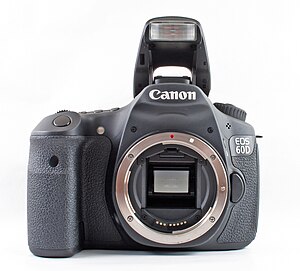Canon EOS 60D: Difference between revisions
No edit summary |
No edit summary |
||
| Line 17: | Line 17: | ||
|fmode = One-shot, AI Servo, AI-Focus, Manual |
|fmode = One-shot, AI Servo, AI-Focus, Manual |
||
|cont = up to 5.3 frames/s |
|cont = up to 5.3 frames/s |
||
|speedRange = 100–6400 (expansion up to |
|speedRange = 100–6400 (expansion up to 12,800) |
||
|rearLCD = 3-inch 3:2 color TFT articulated LCD, 1,040,000 pixels |
|rearLCD = 3-inch 3:2 color TFT articulated LCD, 1,040,000 pixels |
||
|flbkt = none |
|flbkt = none |
||
Revision as of 16:04, 12 October 2011
This article needs additional citations for verification. (August 2010) |
 | |
| Overview | |
|---|---|
| Type | Digital Single-lens reflex |
| Lens | |
| Lens | Interchangeable (EF, EF-S) |
| Sensor/medium | |
| Sensor | CMOS APS-C 22.3 × 14.9 mm (1.6x crop factor) |
| Maximum resolution | 5,184 × 3,456[1] (17.9 megapixels) |
| Film speed | 100–6400 (expansion up to 12,800) |
| Storage media | SD, SDHC or SDXC |
| Focusing | |
| Focus modes | One-shot, AI Servo, AI-Focus, Manual |
| Focus areas | 9 cross-type AF points |
| Focus bracketing | none |
| Exposure/metering | |
| Exposure modes | Full auto, programmed, shutter-priority, aperture priority, manual |
| Exposure metering | TTL, full aperture, 63 zones |
| Flash | |
| Flash | pop-up |
| Flash bracketing | none |
| Shutter | |
| Shutter | focal-plane |
| Continuous shooting | up to 5.3 frames/s |
| Viewfinder | |
| Viewfinder | Optical pentaprism / LiveView LCD |
| Image processing | |
| White balance | 7 presets, Auto and custom 2000–10000 Kelvin, 100 K steps |
| General | |
| LCD screen | 3-inch 3:2 color TFT articulated LCD, 1,040,000 pixels |
| Battery | LP-E6 |
| Weight | 755 g (1.664 lb) |
| Made in | Japan |
The Canon EOS 60D is a digital single-lens reflex camera from Canon. It is part of the Canon EOS line of cameras and succeeds the EOS 50D. It was publicly announced on August 26, 2010.
Main new features in the two-digit Canon line include increased resolution and ISO range, an articulating screen (the first Canon DSLR to have one), full-HD video capabilities and in-camera post-processing functions for the images.
The 60D is offered as a body only or in a package with an EF-S 18-200mm f/3.5-5.6 IS lens or EF-S 17-85 f/4-5.6 IS USM lens or EF-S 18-135 f/3.5-5.6 IS lens.
Changes from 50D
Compared to the EOS 50D the following changes:
- Resolution increase to 18.1 megapixels (50D has 15.1)
- Maximum Sensitivity increased to ISO 6400 (12800 as optional setting) (50D has max 3200 ISO)
- Video recording, with same controls as the 550D
- Manual control of audio recording (Same as newer firmware on 5D MkII)
- Articulating screen with a slightly higher resolution in 3:2 ratio (50D has 4:3)
- Lower maximum burst frame rate of 5.3 fps (50D maximum is 6.3 fps)
- SD/SDHC/SDXC card slot (50D uses CompactFlash)
- Smaller and lighter polycarbonate resin with glass fibre on aluminium chassis (50D has Magnesium alloy body)
- Wireless Speedlite control
- Lack of AF micro-adjustment feature (included in 50D)
- Redesign of controls – multi-controller has been relocated to center of quick control dial; top buttons of 60D control only one setting.
- Locking mode dial
- Electronic level that can be viewed in the viewfinder, rear LCD monitor, and top LCD panel
- LP-E6 battery, as used in the 5D MkII and 7D
- Lack of PC socket for Flash Synchronization
- External shutter release port changed from 'Canon N3' socket to 3/32"(2.5mm) TRS pin.
Digital Photography Review described the changes as representing the move from 'semi-pro'/'prosumer' to 'enthusiast' [2] due to the reduction in some features; however the pentaprism viewfinder and iconic rear control wheel remain, as does the top informational LCD. The slightly smaller body retains the grip of the two-digit Canon line.[citation needed]
-
The articulated display
-
Top view
-
Back view
-
60D with mounted 50mm f/1.8 II - „Nifty Fifty“
References
- ^ "EOS 60D Specifications" (PDF). 2010-08-26. Retrieved 201-08-26.
{{cite web}}: Check date values in:|accessdate=(help) - ^ Thursday, 26 August 2010 04:00 GMT (2010-08-26). "Canon EOS 60D DSLR announced and previewed: Digital Photography Review". Dpreview.com. Retrieved 2010-09-12.
{{cite web}}: CS1 maint: numeric names: authors list (link)
External links
![]() Media related to Canon EOS 60D at Wikimedia Commons
Media related to Canon EOS 60D at Wikimedia Commons




